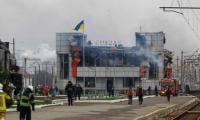The Strategic Restraint Regime (SRR), when Pakistan first offered it to India in 1998 for durable peace in South Asia, was essentially composed of three defining elements – stable deterrence, proportionate reduction in the armed forces and a peaceful resolution of all lingering disputes. In essence, it encompassed those political, military and nuclear dynamics that had over time underlined the conflict between the two, or had the potential to erupt into a conflagration.
The taxonomy as indeed the doctrinal aspects of deterrence only evolved with time, but there was an acute sense of harnessing the destructive power of the nuclear bomb that had found an open expression in May 1998 by both India and Pakistan. Such a moment impelled both sides to move together to evolve a common framework which could eliminate the need for use of such destructive power. The SRR was thus proposed and came under discussion in the immediate aftermath of the nuclear blasts. It was still a malleable proposition by the time A B Vajpayee met Nawaz Sharif in February, 1999. India refused the offer. It needed more statesmanship than was perhaps available at the time.
Pakistan’s thinking on stable deterrence through the proposed SRR was meant to keep South Asia out of a nuclear arms race. The crudest composition of this little understood concept of deterrence only counted matching numbers on both sides.
It was stated by Gen KM Arif, the then VCOAS, that Pakistan expected India to have around a 100 nuclear warheads – which really meant that Pakistan too would have a matching number in its arsenal. Simple conceptions were thus simply stated. The nuances, doctrinal evolutions and technological advancements since have led to bloated inventories on both sides. Not by far, though. Terms such as the Credible Minimum Deterrence (CMD) and the Full Spectrum Deterrence (FSD) – both local connotations - are frequently quoted.
CMD is inherently dynamic in its formulation. The credibility of deterrence as per this concept is an interactive process with the adversary, which per Pakistan’s proclamations is only the Indian threat. So if the Indian capability undergoes change in either developing a more offensive capability or a more assured defensive one against its vulnerability to a Pakistani nuclear attack, Pakistan will tweak its own programme to retain its threatening potential to regain the credibility of its deterrence. Were Pakistan not to do so and were the deterrence to be diluted, it would open itself up to the dominating Indian threat of India’s overwhelming conventional superiority. In this stability-instability paradigm of deterrence, the nuclear programmes on both sides continue to constantly evolve.
That doesn’t mean though that the number of weapons is increasing; there is every likelihood that the arsenal size on both sides has tapered to around 125.It is just that the quality of the arsenal in terms of ranges, yield, effect and employment options continues to optimise. The programmes are thus in a qualitative flux. The proliferation of the delivery means and options is what is of concern. India, with its active space programme, is ahead in many ways and has a number of differently ranged vehicles capable of delivering nuclear weapons over vast ranges. Pakistan has restricted its programme to what will deliver its throw-weight only within Indian continental limits.
The FSD is of even greater pertinence. It essentially includes deterrence that can thwart India’s offensive potential across the entire range of force application. Shallow thrusts by India across the Pakistani borders per its existing operational doctrine – meant to avoid triggering strategic response through deeper incursions – are now neutralised by Pakistan through its short-range, low-yield nuclear weapons of 60 km range. This has kept India’s armed belligerence at bay, and delivered to South Asia the longest period of absence of a conventional war between the two warring neighbours.
When India and the US ask Pakistan to do away with its ‘tactical’ nuclear weapons, it is akin to forcing Pakistan to reveal its window of vulnerability allowing India to apply its superior conventional force in a limited war against Pakistan. Any escalation from even a limited force engagement only means an uncontrolled hurtle towards a full-blown nuclear conflict. So to avoid a devastating war, ‘tactical weapons are good. This frustrates India, but keeps peace in South Asia.
The US has other reasons for concern on Pakistan’s limited range weapons. Its own experience of these weapons informs these fears. In the US’ historical experience tactical nuclear weapons were located close to the intended users of these weapons, which in Europe was practically a case of deployed forces against the former Warsaw Pact and hence delegated in possession and control to that level for immediate use.
In the Pakistani context however, the weapons are hardly ‘tactical’ despite being short-range and limited in effect because their control, ownership and possession remains outside the purview of deployed forces and within higher control like for all other weapons. Similarly, their deployment and use will be authorised as for any other strategic weapon.
It is more accurate to characterise the ‘tactical’ as ‘short-range strategic’ weapons, at least in Pakistan’s case. That makes them proliferation proof within the same sense of security that applies to Pakistan’s complete arsenal. Non-deployed, non-mated weapons are the surest means of keeping South Asia from a knee-jerk overreaction, as well as avoiding the possibility of misuse.
Pakistan seeks to ‘avoid’ war with its deterrence; India ‘seeks’ a window to apply its superior conventional capability. The US is wary of a possible loss or misuse of a smaller nuclear warhead. Of these three interactive players the US needs to understand Pakistan’s nuclear control mechanism better, while the dynamism in the CMD part of the doctrinal formulation, in both India and Pakistan, must now cease to stymie further expansion.
The FSD is good and should stay to keep war out from South Asia. But how do you get the two from a ‘vertical’ proliferation? The US-USSR experience is instructive.
The writer is a retired air-vicemarshal, former ambassador and a security and political analyst.
Email: shhzdchdhry@yahoo.com















